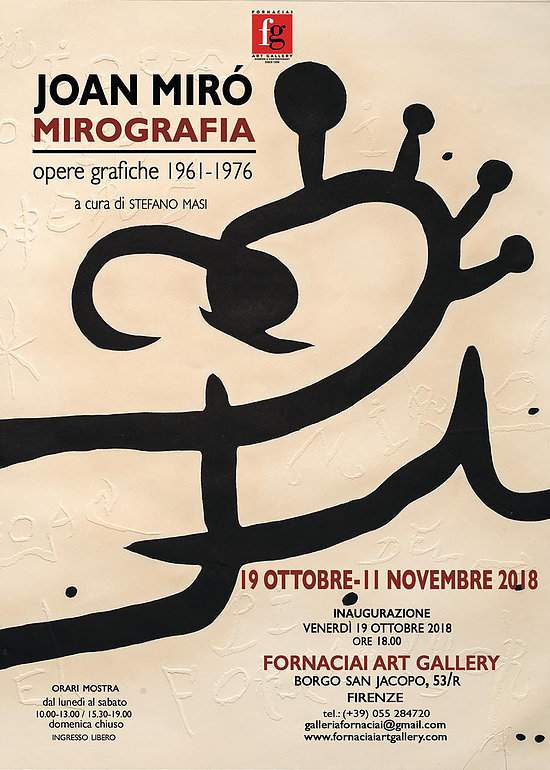22 graphic works by Joan Miró on display at Fornaciai Art Gallery in Florence, Italy
From October 19 toNovember 11,2018, Fornaciai Art Gallery in Florence will host the exhibition Joan Miró. MIROGRAPHY: graphic works 1961-1976, curated by Stefano Masi. Twenty-two works by the Catalan artist from a private collection will be on display, most of them presented to the public for the first time.
The exhibition opens with five etchings from the 1971 Album Espriu-Mirò, published by the historic Barcelona gallery Sala Gaspar: the frontispiece and four etchings, originally accompanied by as many poems by the Catalan writer Salvador Espriu, all printed on Guarro handmade paper and signed by the artist. Also among the works on display are the five engravings commenting on El Pi de Formentor, a poem by Costa Llobrera considered one of the masterpieces of Catalan Romantic poetry, which draws inspiration from the pine trees that dot the steep walls of the Formentor promontory in the northernmost part of Majorca, a place dear to both the poet and Miró.
Also noteworthy are the lithograph Album 19, one of the most representative ones Miró executed in the early 1960s, and Ronde de Nuit, conceived for No. 186 of the legendary Parisian magazine founded in 1946 by Aimé Maeght, “Derrière le Miroir,” which published numerous lithographs by the most important artists exhibiting at the Galerie Maeght in Paris such as Chagall, Giacometti, Kandinsky and Matisse.
Finally, standing out among others are six color lithographs from the series Homenatge a Joan Prats, published in 25 copies in 1971, all numbered and signed by the artist. The lithographs are a tribute to Juan Prats, Catalan artistic and cultural promoter and founder with Miró of the Joan Miró Foundation in Barcelona.
Introduced to engraving techniques by the Polish-born Cubist painter Louis Marcoussis, in his Parisian studio, equipped with a press, Miró learned a wide variety of engraving techniques, which soon began to play a not insignificant role in his artistic production, to the point that he said, “engraving enriches my painting; it suggests new ideas to me; it pushes me to create on new bases. Everything is connected.”
In New York during the 1940s, Miró continued to explore intaglio techniques, but it would be the art dealer Aimé Maeght, of the Paris gallery of the same name, founder of theImprimerie ARTE(Arts et Techniques graphiques) and the magazine “Cahiers du miroir,” to make him increasingly passionate about the world of lithography, publishing numerous single etchings, albums and portfolios, but also posters, invitations, book covers and even postcards.
The year 1967 marked a turning point in his graphic production, when he was introduced by his friend Robert Dutrou to the carborundum technique, which, developed by French-American painter and engraver Henri Bernard Goetz, involves the addition of silicon carbonate, known as carborundum, to the etching plate in order to create a rough, grainy surface (L’Astre du labyrinthe, one of the very first examples of the use of this technique, is on display). By combining carborundum with other intaglio methods learned throughout his artistic career, including in particular the more traditional aquatint, Miró forged “images capable of rivaling any kind of painting.”
The result of a lucid surrender to his own inspiration, the Catalan artist’s graphic production is made possible by the paradoxical union between the unconscious dimension, the seat of his creative magma, and the conscious knowledge of the expressive medium and printing processes, as he himself hints at when he writes, “For lithography and engraving, one must dominate fate, but never be dominated by it.” This is the terrain in which the profound bond Miró has always manifested with poetry is also expressed, and especially with that of the main exponents of the twentieth century, especially the French and Catalans, whose verses he often illustrated, elaborating an ad hoc artistic language made up of those mysterious signs, almost enigmatic hieroglyphics, which Raymond Quenau not wrongly calls “myrogliphics.”
Opening hours: Monday through Saturday from 10 a.m. to 1 p.m. and 3:30 to 7:30 p.m.
Free Admission.
 |
| 22 graphic works by Joan Miró on display at Fornaciai Art Gallery in Florence, Italy |
Warning: the translation into English of the original Italian article was created using automatic tools. We undertake to review all articles, but we do not guarantee the total absence of inaccuracies in the translation due to the program. You can find the original by clicking on the ITA button. If you find any mistake,please contact us.





























